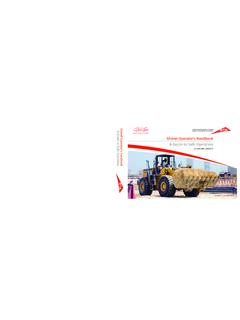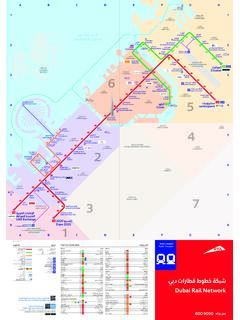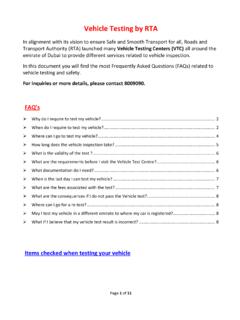Transcription of Forklift Operator’s Handbook A Guide to Safe Operation
1 Forklift operator s Handbook A Guide to Safe OperationRTA Website: Center Tel: 800 90 90 Copyright Roads and Transport Authority (RTA) 2008 Forklift operator s Handbook A Guide to Safe Operation LICENSING AGENCY1st Edition November 2008 Forklift Handbook A Guide tO SAFe OPeRAtiON1 Table of Contents introduction 5 What this Handbook is About 5 Why Read this Handbook 5 How to use this Handbook 5 How You Will Learn 6 Symbols 7 Part 1: Licence to Operate a Forklift 9 eligibility Criteria 9 Learning to Operate a Forklift 9 Part 2: types and Components of forklifts 13 types of forklifts 13 Components of forklifts 16 Forklift Handbook A Guide tO SAFe OPeRAtiON2 Forklift Controls 18 Mast and Lifting Mechanism 19 Manufacturer s data Plate 19 types and use of different tyres 20 Rear Wheel Steering 21 Forklift Attachments 22 Part 3 : Forklift Safety 27 Forklift Speed 27 Refuelling the Forklift 28 Safe Working Practices 29 daily Pre-drive inspections 30 Section: Contents3 Part 4 : Forklift Operation 35 Mounting and dismounting 35 Start-up Procedure 36 Moving Procedure 38 Parking the Machine 40 Loading the Forklift truck 41 What Should an operator Avoid When Operating a Forklift ?
2 45 using Attachments 46 Causes of tipping 47 Safety Facts 48 Forklift Handbook A Guide tO SAFe OPeRAtiON45 IntroductionWhat this Handbook is Aboutthis Handbook is about the skills and knowledge required to safely operate a Forklift . the Handbook is for either a light Forklift with an empty weight of not more than tonnes, or a heavy Forklift with an empty weight is of more than tonnes. the training course for both types of forklifts is the same. the licence issued will depend on the Forklift used for the licence tests at the completion of the Read this Handbookthis Handbook tells you about some of the legal requirements for drivers of light and heavy mechanical equipment ( Forklift ) in dubai, along with important safety information, background material, technical information and safe operating knowledge test that you must pass to drive a Forklift is based on the information in this Handbook .
3 You need to understand it to pass your to use this Handbookthe table of Contents will show you where to find each section. At the end of each section, there is a section called test Yourself Questions to help you check if you have understood important You Will LearnLearning to operate a Forklift is like any other complex task. if you break the task into small, manageable pieces and do not try to learn too many things at once, it is much easier. You will:develop the knowledge and skill needed to operate forklifts be shown how to drive and control forklifts safely practise and correct your driving techniques in an increasingly complex set of conditions, so that you are capable of successfully undertaking your licence length of each stage of learning depends on the amount of practice you have had. Be sure you are confident and competent before moving on to the next stage. Your instructor will advise you when you are ready to move fast and how much you learn will depend on you.
4 You should learn by:reading this Handbook carefully attempting all the questions and activities in the Handbook observing the operations being performed by your instructor and on your work site asking questions practising the new skills included in this Handbook undertaking the assessment tasks on completion of the training. if there is anything in this Handbook you do not understand or do not agree with, do not be afraid to ask your instructor for Handbook A Guide tO SAFe OPeRAtiON7 SymbolsGraphic symbols are used to Guide your learning and identify types of information. the meaning of each symbol is as follows:Caution You must follow instructions to avoid damage to products, a process or You must follow safety procedures or wear protective Yourself Questions Check that you have understood the information in this section by answering the questions at the end of each Handbook A Guide tO SAFe OPeRAtiON9 Part 1: Licence to Operate a Forklifteligibility Criteriathe eligibility criteria for a licence to operate a Forklift are set out below:You may drive a Forklift if you: are over 20 years of age have passed an eye test have undertaken Forklift training until competency is shown and have passed an appropriate knowledge test have passed a practical test pay the appropriate you meet these criteria, you will be issued with either.
5 A Light Tractor and Mechanical Equipment licence if you have been tested in a Forklift with an empty weight of not more than tonnes, which permits you to operate light mechanical equipment only or a Heavy Tractor and Mechanical Equipment licence if you have been tested in a Forklift with an empty weight of over tonnes, which permits you to operate both light and heavy mechanical to Operate a Forkliftuntil you get your Forklift licence, you may only drive a Forklift if you are under the supervision of an instructor who holds a valid licence for the type of vehicle you are Yourself QuestionsQ1 What age must you be to apply for a licence to operate a Forklift ?Q2 Do you have to pass any tests to obtain a licence to operate a Forklift ? Forklift Handbook A Guide tO SAFe OPeRAtiONAQ1 You must be over 20 years of Yes, a knowledge test and a practical 1: Licence to Operate a Forklift12 Forklift Handbook A Guide tO SAFe OPeRAtiON13 Part 2 : Types and Components of Forkliftstypes of ForkliftsA Forklift is a vehicle similar to a small truck that has two metal forks on the front used to lift cargo.
6 The Forklift operator drives the Forklift forward until the forks push under the cargo, and can then lift the cargo several feet in the air by operating the forks. the forks, also known as blades or tines, are usually made out of steel and can lift up to a few tonnes, depending on the capacity of the Forklift and the are used to: transport loads between areas stack heavy objects load and unload are a wide range of forklifts , including pedestrian operated and ride on vary in size, ranging from one tonne capacity for general warehouse type work, up to 50 tonne capacity for shipping container Handbook A Guide tO SAFe OPeRAtiONThere are two main types of motors used in forklifts :Internal combustion motors which may be fuelled by petrol, diesel or liquid petroleum gas (LPG). internal combustion powered forklifts must not be used in confined spaces, as people working in the confined space may be overcome by the powered electric motors.
7 Gasoline or propane forklifts are sometimes stronger or faster than electric forklifts , but they are more difficult to maintain. electric forklifts are great for warehouse use because they do not give off dangerous fumes like gas powered contain sulphuric acid which is very corrosive to human tissue and the surrounding environment. When you handle a battery you should wear protective clothing, including:eye protection gloves acid resistant boots face mask protective apron. You will need to be careful when lead acid batteries are being recharged because it is possible for a level of hydrogen to build up that will explode if a spark or naked flame is should take the following steps to reduce the risk of hydrogen building up and creating an explosion:only recharge batteries in designated well ventilated recharging areas make sure there are no flames or sparks around use the isolation switch to ensure that the Forklift circuit is open before disconnecting the battery terminals, so no sparking occursmetal tools or fittings must not come in contact with the terminals, as they may create a spark.
8 15 forklifts are most often used in warehouses, but some are meant to be used outdoors. the vast majority of rough terrain forklifts operate on gasoline, but some use diesel or natural gas. Rough terrain forklifts have the highest lifting capacity of all forklifts and have heavy duty tyres (like those found on trucks), making it possible to drive them on uneven surfaces Balanced and Non-counter Balanced ForkliftsForklifts are divided into two types based on how they are able to remain stable when they are loaded. these types are Counter Balanced and Non Counter Balanced Balanced forklifts have the weight of the load carried outside the wheel base and are counter balanced by the weight of the counter balanced forklifts , the weight of the rear of the truck counterbalances the weight of the load being carried at the front of the Forklift .
9 The front wheels can act as a pivot point on which the Forklift and load can tip. the greater the weight of the counter balance of the Forklift , then the heavier the load that can be lifted. Heavier loads can be lifted if the counter balance is further back in the balanced forklifts have the load carried inside the wheel base of the Forklift . Non counter balanced forklifts keep their stability by having the wheels mounted on arms that are on either side of the load when it is being picked up and transported. these are often called straddle lift 2: types and Components of Forklifts16 Components of ForkliftsAll forklifts have similar components but these may be located in different places, depending on the type of Forklift : Class 1 forklifts are electric -motor rider trucks, either stand-up operator or seated three-wheel units. Rider units are counterbalanced and may have cushion or pneumatic 2 forklifts are electric -motor trucks for narrow aisle or inventory stock/order picking applications.
10 They may have extra reach or swing-mast 3 forklifts are electric -motor trucks, either walk-behind or standing-rider operated. Automated pallet lift-trucks and high-lift models are often 4 forklifts are rider fork trucks, with cabs and seated controls, internal combustion engines, and solid or cushion tyres. Class 4 forklifts are sit-down rider, tow tractor lifts. they are supplied with electric or internal combustion 5 forklifts are rider fork trucks, with cabs and seated controls, internal combustion engines and pneumatic tyres. they are typically 6 forklifts are designed for use on rough terrain. typical applications include agriculture, logging and construction. Forklift Handbook A Guide tO SAFe OPeRAtiON17these are the key components of a Forklift that you will need to know:A mastB lift cylinderC load backrest that prevents the load falling on the operatorD fork carriageE forksF tilt cylinderG overhead cageH driver seatI drive wheels and axleJ steering axle and wheelsK counter balanceL warning sure you know where these are located on the type of Forklift you will be operating and how to operate 2: types and Components of ForkliftsABCDEFGHIJKL18 Forklift Controlsthe operating panel of Forklift trucks provides the operator with the following features:Inching brake pedal (All terrain models) this brake pedal is located on the left side of the steering column and works as a clutch pedal because of the inching valve built in the hydraulic system.



